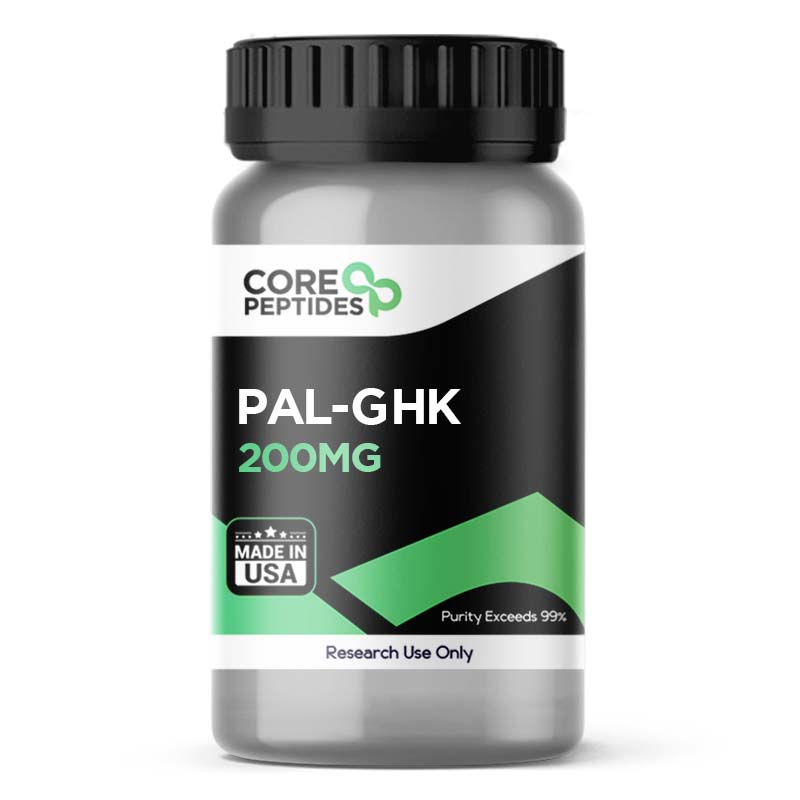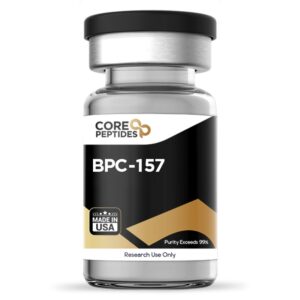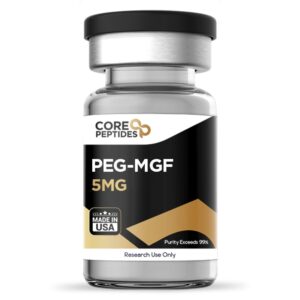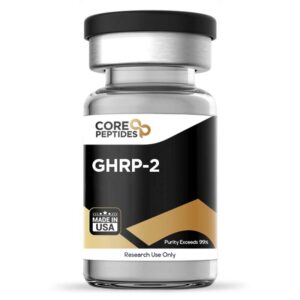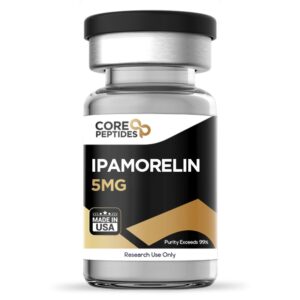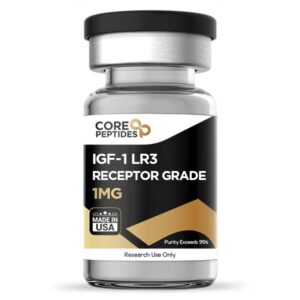Pal-GHK (200mg)
$165.00
Size: 200mg
Contents: Pal-GHK
Form: Lyophilized powder
Purity: >99%
SKU: P-PAL-GHK
FREE Shipping on $200+ orders
Discount per Quantity
| Quantity | Discount | Price |
|---|---|---|
| 5 - 8 | 5% | $156.75 |
| 9 + | 10% | $148.50 |
Pal-GHK Peptide
Palmitoyl-GHK, also known as palmitoyl-tripeptide-1, is a synthetic hybrid molecule consisting of a chain of three amino acids attached to a palmitic acid molecule. The GHK sequence, which consists of the amino acids Gly-His-Lys, is found naturally in plasma, discovered in 1973 by Pickart et al.(1) The addition of palmitoyl to the molecule is thought to result in better penetration through the stratum corneum of the epidermal barrier.(2) The palmitoyl group, which is a fatty acid chain, is thought to increase lipophilicity, which may potentially enhance the compatibility of the molecule with the lipid-rich environment of the stratum corneum. The added palmitoyl group might also act as a penetration enhancer by disrupting the tightly packed lipid structure of the stratum corneum. This disruption could temporarily loosen the lipid matrix, allowing Pal-GHK and other agents to permeate through various skin tissue models.
Researchers have suggested that Pal-GHK may stimulate collagen production, a key component of the skin's extracellular matrix (ECM). This hypothesis was initially developed because the Gly-His-Lys sequence is also a structural fragment of the protein collagen. Gly-His-Lys is believed to be released during collagen hydrolysis, typically induced in tissue repair and to mitigate inflammation. Therefore, the tripeptide is believed to act as a natural feedback signal to fibroblasts, the cells responsible for producing collagen and other ECM components.
Pal-GHK may also exhibit antioxidant potential against damage caused by free radicals. Free radicals are unstable molecules that may damage cell structures and are considered to contribute to the aging process. By potentially neutralizing free radicals, Palmitoyl-GHK may reduce cellular aging and inflammation.
Chemical Makeup
Molecular formula: C30H54N6O5
Molecular weight: 578.8 g/mol
Other Known Titles: Palmitoyl Tripeptide-1, Palmitoyl oligopeptide, Biopeptide-CL
Research and Clinical Studies
Pal-GHK and Collagen Synthesis
Research by Maquart et al. dating back to 1988 and published in the journal FEBS Letters suggests that the Gly-His-Lys in Pal-GHK is a fragment produced during the hydrolysis of collagen.(3) Such fragments are produced when collagen is damaged, and they may signal fibroblasts to initiate the process of collagen synthesis. Pal-GHK may have a similar potential to stimulate collagen, elastin, and glycosaminoglycans, important components of the extracellular matrix of the skin. The researchers concluded, "The presence of a GHK triplet in the alpha 2(I) chain of type I collagen suggests that the tripeptide might be liberated by proteases at the site of a wound and exert in situ healing effects."
A placebo-controlled clinical study suggests that Pal-GHK may stimulate collagen synthesis, as concluded following the assessment of the apparent effect of the peptide on skin thickness. The trial involved twenty-three subjects, and the researchers reported a small but statistically significant increase in skin thickness of about 4% compared to the placebo.(5)
Pal-GHK and Wrinkle Depth
A clinical study was conducted to ascertain the peptide’s potential in reducing the depth and length of wrinkles along the stratum corneum. The study evaluated the action of the peptide in a cream form (6) and included fifteen subjects. The scientists reported an apparent reduction in wrinkle length, depth, and texture inconsistency (roughness) following the study period.
Another clinical experiment involved a combination of Pal-GHK tripeptide and another palmitoylated peptide called Pal-GQPR.(7) Pal-GQPR is a tetrapeptide with the sequence of Pal-Gly-Gln-Pro-Arg, and it is a fragment of immunoglobulin G (IgG) which is considered to play an important role in reducing the amount of interleukin 6 (IL6) production. The design was a blind, randomized clinical study that included twenty-eight subjects. There was an apparent reduction of wrinkle depth, volume, density, texture inconsistency, and the area occupied by deep wrinkles following exposure to the combination of the two palmitoylated peptides.
Pal-GHK and Antioxidation
A 2018 laboratory experiment by Sakuma et al. suggested that the amino-acid sequence of Pal-GHK may have antioxidative potential.(8) The researchers also reported that this potential was apparently more powerful than other compounds classified as antioxidative and commonly used in research, such as carnosine and reduced glutathione. More specifically, the researchers shared that "Experiments utilizing an ESR spin-trapping technique revealed that, among hydroxyl (·OH), superoxide (O2-·), and peroxyl (ROO·) radicals generated by respective chemical reaction systems, GHK diminished signals of both ·OH and ROO·."
Active radicals appear to be apparent mediators of photodamage. Examples of such active radicals include reactive oxygen species (ROS), reactive nitrogen species (RNS), and reactive carbonyl species (RCS), which are considered to cause harm to lipids, DNA, and proteins. Studies have suggested that the amino acid sequence found in Pal-GHK may potentially prevent protein glycation and may possess anti-RCS properties against various radicals like acrolein, malondialdehyde, and 4-hydroxynoneal.(9)
Additionally, Pal-GHK has been suggested to have the potential to reduce the release of iron from ferritin, which catalyzes lipid peroxidation. In other words, Pal-GHK may lead to a lower rate of lipid peroxidation, ostensibly preserving the integrity of cell membranes and reducing cellular damage. In the context of skin tissue integrity, this might contribute to enhanced skin cell function and survival. One study shared results of an apparent 87% decrease in the iron release from damaged tissue using Pal-GHK, which appeared to have reduced oxidation in the affected tissues.(10) By potentially lowering lipid peroxidation, Pal-GHK might indirectly help mitigate the alteration of DNA and proteins, potentially reducing risk factors that may otherwise lead to cellular damage.
Pal-GHK may also potentially reduce the production of reactive oxygen species and inflammatory cytokines while increasing the activity of antioxidant enzymes. During one experiment using a murine model, Pal-GHK was suggested to suppress the activation of Nuclear Factor kappa-light-chain-enhancer of activated B cells (NF-κB) and p38 mitogen-activated protein kinase (MAPK) signaling pathways, both of which are associated with inflammation.(11) Pal-GHK might potentially inhibit the activation of p38 MAPK either by blocking the upstream kinases that activate it or by interfering with the signaling molecules that initiate its phosphorylation. The inhibition may conceivably suppress the inflammatory response, reducing the overall stress on cells. This may lead to reduced infiltration of inflammatory cells in the tissues of murine models of lung tissue damage and lower levels of TNF-1 and IL-6 production.
Researchers have also speculated about Pal-GHK's potential to alleviate the oxidative stress of smoke inhalation. Research findings have led to the proposal that the amino-acid sequence of Pal-GHK might impede oxidative stress in alveolar epithelial cells by increasing Nrf2 (Nuclear factor erythroid 2-related factor 2) expression and reducing the levels of reactive oxygen species in cell cultures.(12) Nrf2 is a protein that may regulate the expression of antioxidant proteins that protect against oxidative damage triggered by injury and inflammation.
Pal-GHK peptide is available for research and laboratory purposes only. Please review and adhere to our Terms and Conditions before ordering.
References:
- Pickart, L., & Thaler, M. M. (1973). Tripeptide in human serum which prolongs survival of normal liver cells and stimulates growth in neoplastic liver. Nature: New biology, 243(124), 85–87.
- Gorouhi, F., & Maibach, H. I. (2009). Role of peptides in preventing or treating aged skin. International journal of cosmetic science, 31(5), 327-345.
- Maquart, F. X., Pickart, L., Laurent, M., Gillery, P., Monboisse, J. C., & Borel, J. P. (1988). Stimulation of collagen synthesis in fibroblast cultures by the tripeptide-copper complex glycyl-L-histidyl-L-lysine-Cu2+. FEBS letters, 238(2), 343–346. https://doi.org/10.1016/0014-5793(88)80509-x
- Trookman, N. S., Rizer, R. L., Ford, R., Mehta, R., & Gotz, V. (2009). Clinical assessment of a combination lip treatment to restore moisturization and fullness. The Journal of clinical and aesthetic dermatology, 2(12), 44–48.
- Lintner, K., & Peschard, O. (2000). Biologically active peptides: from a laboratory bench curiosity to a functional skin care product. International journal of cosmetic science, 22(3), 207–218. https://doi.org/10.1046/j.1467-2494.2000.00010.x
- Schagen, S. K. (2017). Peptide treatments with effective anti-aging results. Cosmetics, 4(2), 16.
- Fournial, A., & Mondon, P. New Cosmetic or Dermopharmaceutical Use of a Mixture of a Ghk Tripeptide and Gqpr Tetrapeptide.
- Sakuma, S., Ishimura, M., Yuba, Y., Itoh, Y., & Fujimoto, Y. (2018). The peptide glycyl-ʟ-histidyl-ʟ-lysine is an endogenous antioxidant in living organisms, possibly by diminishing hydroxyl and peroxyl radicals. International journal of physiology, pathophysiology and pharmacology, 10(3), 132–138.
- Cebrián, J., Messeguer, A., Facino, R. M., & García Antón, J. M. (2005). New anti-RNS and -RCS products for cosmetic treatment. International journal of cosmetic science, 27(5), 271–278. https://doi.org/10.1111/j.1467-2494.2005.00279.x
- Park, J. R., Lee, H., Kim, S. I., & Yang, S. R. (2016). The tri-peptide GHK-Cu complex ameliorates lipopolysaccharide-induced acute lung injury in mice. Oncotarget, 7(36), 58405–58417. https://doi.org/10.18632/oncotarget.11168
- Sakuma, S., Ishimura, M., Yuba, Y., Itoh, Y., & Fujimoto, Y. (2018). The peptide glycyl-ʟ-histidyl-ʟ-lysine is an endogenous antioxidant in living organisms, possibly by diminishing hydroxyl and peroxyl radicals. International journal of physiology, pathophysiology and pharmacology, 10(3), 132–138.
- Zhang, Q., Yan, L., Lu, J., & Zhou, X. (2022). Glycyl-L-histidyl-L-lysine-Cu2+ attenuates cigarette smoke-induced pulmonary emphysema and inflammation by reducing oxidative stress pathway. Frontiers in molecular biosciences, 9, 925700. https://doi.org/10.3389/fmolb.2022.925700

